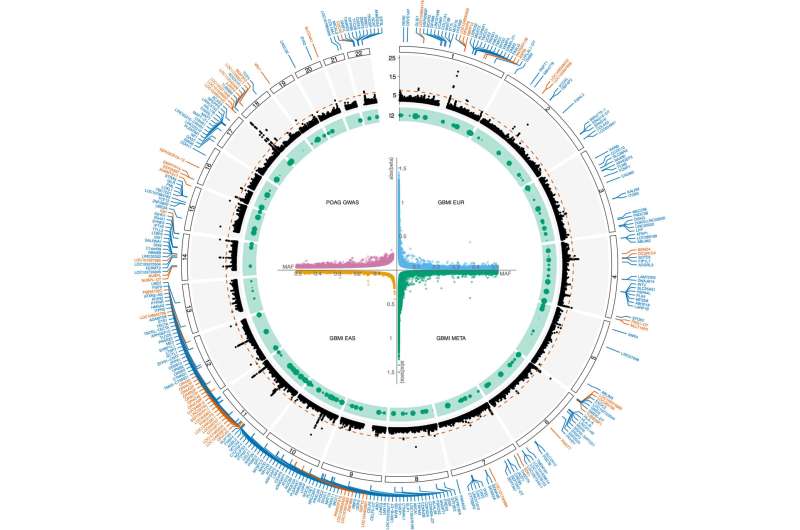This article has been reviewed according to Science X's editorial process and policies. Editors have highlighted the following attributes while ensuring the content's credibility:
fact-checked
peer-reviewed publication
trusted source
proofread
Study with over 11,000 individuals of African descent finds genetic variants linked to glaucoma

Glaucoma is the leading cause of irreversible blindness around the globe, affecting up to 44 million people. Although people of African ancestry are most frequently and severely affected by this hereditary disease, its genetic underpinnings in this population have rarely been studied.
Now, a team of investigators has published findings revealing previously unknown inherited genetic variants that contribute to primary open-angle glaucoma (POAG), the most common form of the disease. The study was based on the analysis of 11,275 individuals of African descent and is published January 18, 2024, in Cell.
"Individuals with African ancestry are five times more likely to be affected by glaucoma and up to 15 times more likely to experience vision loss or blindness from the disease compared to individuals with European ancestry," says corresponding author Joan O'Brien, MD, Director of the Penn Medicine Center for Genetics of Complex Disease.
"Our current treatments for this blinding disease are inadequate, and precision medicine could be applied if we more clearly understood the full pathophysiology of this inherited neurodegeneration."
O'Brien explains that this research was made possible thanks to key contributions from glaucoma specialists of African ancestry and other Black community leaders living in the Philadelphia area, who were able to boost enrollment in the research because of increased trust within the community. Scientists from fields including genetics, ophthalmology, and computational biology also made important contributions to the paper.
POAG can occur when normal drainage of eye fluid becomes blocked, leading to a buildup of pressure within the eye. If the intraocular pressure rises too much, it can damage the optic nerve and result in permanent vision loss.
People with POAG generally experience a loss of peripheral vision first, followed by loss in the central field of vision. Unfortunately, the disease has no early symptoms, and by the time vision loss is experienced, permanent damage usually has already occurred.
"Elevated intraocular pressure is currently the only targetable component of the disease, but many patients maintain normal pressure levels or do not respond to pressure-lowering therapies," says co-author Rebecca Salowe, MSE, Research Project Manager at UPenn. "This suggested to us that POAG has additional underlying mechanisms that could be elucidated by genetic studies."
In this study, the investigators worked with Black community leaders to organize glaucoma screenings in churches and senior centers. They also worked with a Black-owned radio station (WURD Radio) on a campaign promoting the importance of glaucoma screening in the Black community. The screenings were free, and participants received free lunch whether or not they agreed to enroll in the study.
The investigators ultimately were able to collect data and genetic samples for 11,275 people (6,003 individuals with glaucoma and 5,272 controls). Importantly, the enrollees were also given the opportunity to either enroll in or opt out of future studies.
Using genome-wide association studies and other forms of genetic analysis, the team identified two novel gene variants implicated in the formation of glaucoma. These variants were rs1666698, which is tied to the gene DBF4P2, and rs34957764, which is linked to the gene ROCK1P1.
A third variant, rs11824032, which is tied to ARHGEF12, was also identified. This variant was previously associated with cup-to-disk ratio, a measure of glaucoma severity, in a genetic co-localization analysis.
When the team compared their findings to results primarily featuring people of European descent, they found these variants were more common in people of African ancestry.
"This work highlights the essential role of diversity in genetic research," says Shefali Verma, Ph.D., an assistant professor in pathology and laboratory medicine at UPenn.
"Without our focus on this specific ancestry group, these unique and critical insights might have remained lost, and we would not have been able to substantially enhance our understanding of the genetics behind POAG in this overaffected population."
The researchers were able to validate results in the Penn Medicine BioBank, an in-house repository of genetic information linked to health records. It includes a particularly diverse collection of genetic material.
"To enhance our work, we were able to identify patients in the Penn Medicine BioBank with glaucoma and controls to validate the genetic effects we gleaned from the initial cohort we analyzed," explains Marylyn Ritchie Ph.D., director of the Institute for Biomedical Informatics at UPenn. "Without that resource, it would have been much more difficult to produce such strong work."
The team is currently focused on developing better methods for diagnosing glaucoma early, when it's most amenable to treatment. Using identified variants, the team developed a polygenic risk score that outperformed a similar risk score developed using information from individuals of European ancestry. This improved risk score could help patients make decisions about screening and treatment for glaucoma before it produces vision loss.
"We are now working with community leaders to lead us in determining which other diseases over-affect this understudied population and are of greatest importance for further screening and research," O'Brien says.
"We are also sharing our genetic database with other researchers across departments and schools that are studying diseases that over-affect African ancestry populations. These collaborations are resulting in much more research on the health of a population that has been historically understudied."
More information: A multi-cohort genome-wide association study in African ancestry individuals reveals risk loci for primary open-angle glaucoma, Cell (2024). DOI: 10.1016/j.cell.2023.12.006. www.cell.com/cell/fulltext/S0092-8674(23)01338-7

















